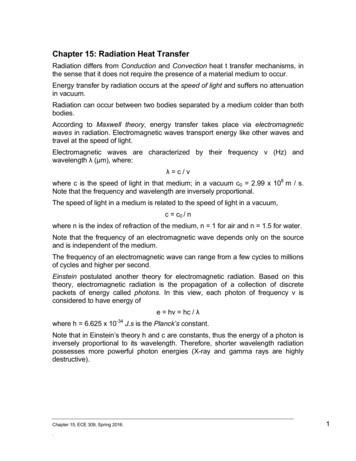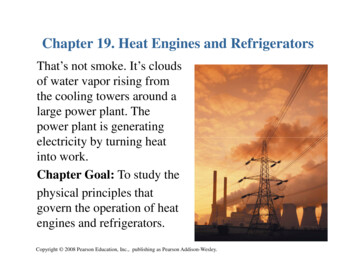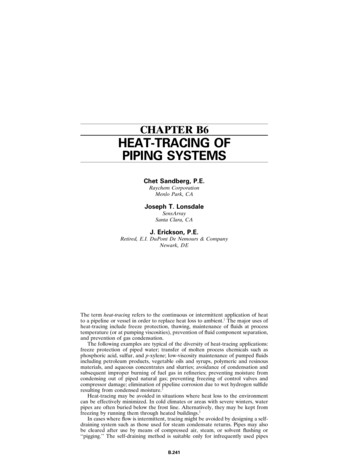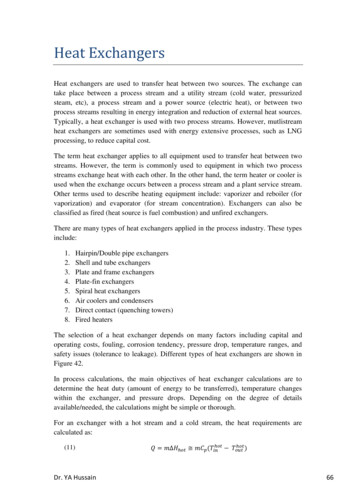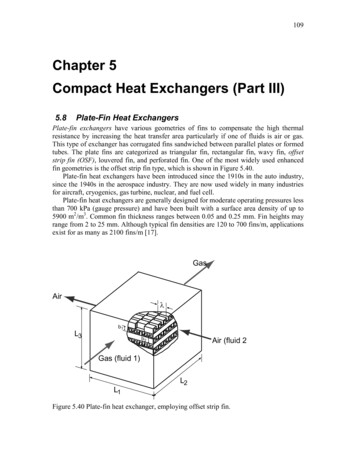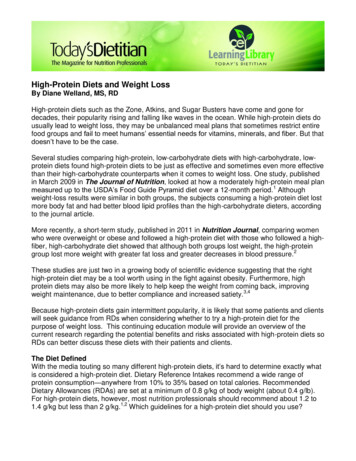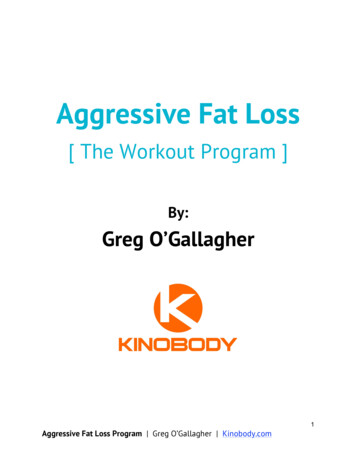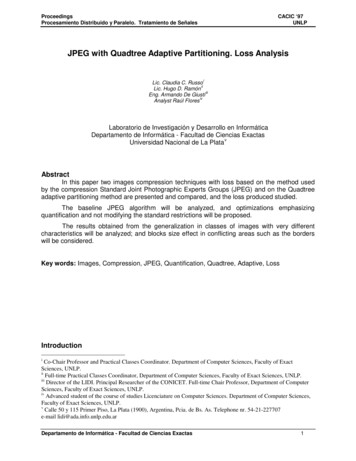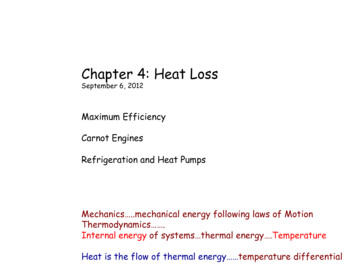
Transcription
Chapter 4: Heat LossSeptember 6, 2012Maximum EfficiencyCarnot EnginesRefrigeration and Heat PumpsMechanics .mechanical energy following laws of MotionThermodynamics .Internal energy of systems thermal energy .TemperatureHeat is the flow of thermal energy temperature differential
Temperature Scales Conversion to Fahrenheit: F (1.8 x C) 32 Conversion to Celsius: C ( F – 32)/1.8
Specific Heat CapacitySpecific heat capacity– Quantity of heat needed to raise 1g of asubstance by 1 C (K)Water– Highest specific heat– 1 cal/g KMercury 0.033 cal/g.KHeat capacity (C), is the proportionality between the amount of heat and the changeIn temperature that this object produces.Q C(Tfinal –Tinitial)
Heat is the flow of thermal energy temperature differential Conduction– Movement of heat by atomic-scale collision– Thermal conductivity Convection– Bulk transfer of molecules– Convection cell Radiation
Infrared Imaging DetectsHeat Loss
Why wear black in the dessert?Why do arctic animals have whitefeathers?/fur?
The First Law of ThermodynamicsThe Second Law of ThermodynamicsHeat does not flow spontaneously from cold to hotCan you do it?Efficiency of an Engine:Determined by the second law of thermodynamics
Built-in Limitationsof the Universe The Second Lawʼs consequences– Some things cannot happen
essHeatflow kArea(Thot- ‐Tcold)- ‐- ‐- ‐- ‐- ‐- ‐- ‐- ‐- ‐- ‐- ‐- ‐- ‐- ‐- ‐- ‐- ‐- ‐thickness
ratetheirownenergy.
R-Values of Common Building Materials!TheR- - block(8")R- R value latedstudwall14Brick(4")R- tudwall14WoodenFrameR- alPanelR- a;ng65
Calculate the heat transfer for 12 hrs though an insulated window (two glass panesWith an air gap of 0.25 in) that measures 4ft by 7 ft when the outside temperatureis 5 degrees F and the inside temperature is 65 degrees F.R value for this type of window is 1.54 ft2.hr.F/BtuHeat flow k Area (Thot-Tcold)---------------thicknessR value thickness/kHeat flow (1/R )Area (Thot-Tcold)Area 4\x7\ 28\2Temperaturedifferenceis65- ‐5 60degreesFHeatflow 12hrsx28\2x50Fx1/1.54\2.hr.F/Btu 13,100Btu
terials combina;onofmaterialsCellulosefiber fiberglass pinewood brickFiberglassFiber6”7”Wood18”Brick110”R total Rcellulose fiber R fiberglass Rwood Rbrick
Example:Consider an exterior wall that consists of ½ in of plasterboard, 3.5inches of fiberglass insulation, ¾ in plywood, and ½ in lapped woodsiding .a) What is the effective R value?b) What is the hourly heat loss from a house in which all the exteriorsurfaces have this R value when the inside temperature is 65 F andthe outside temperature is 15 F. The dimensions of the house are 30ft x 50 ft x 10 ft.plaplswytoinsula;onweooordd
The First Law of ThermodynamicsThe Second Law of ThermodynamicsHeat does not flow spontaneously from cold to hotCan you do it?Efficiency of an Engine:Determined by the second law of thermodynamics
What is the problem?EfficiencyEngines:Efficiency work done/energy put into the system What you got out/What you put in100% efficiency not possible .friction, viscosityinsulationotherA heat engine is a physical or theoretical device that converts thermal energyto mechanical output. The mechanical output is called work, and the thermal energyinput is called heat.
All fossil fuels and biomasses consist of carbon and hydrogen atoms.When these fuels are burned, or "combusted," carbon atoms unite with oxygen inthe air to form carbon dioxide.
Think of an engine as operating between two thermal reservoirs One at High Temperature engine takes the heat (QH from hot reservoirdoes work with it and returns the rest to the cooler reservoir Energy Conservation . QH Work QCIf you want engine to operate you must provide QHEfficiency W/QH
No perfect engines .We can only convert some of the heat to worknot all of it 2nd Law of Thermodynamics Entropy Time Travel “Beam me up Scotty”
Example: In the US, 85% of the electricity isgenerated by burning fossil fuels to produce steam,Which in turn drives alternators that produceelectricity. Power plants can produce steam with atemperature as high as 6000C by pressurizing thesteam. The resulting waste heat must be exhaustedinto the environment at a temperature of 200 C(1- Tcold/Thot)x 100% maximum efficiency600 273 873 degree Kelvin20 273 2931-(293/873) x 100% 66.4%Real power plants .40%
Maximum Efficiency Equatorial lake is 10,000 m2 in surface area Sun deposits 0.500 kW/m2 into the lake.What is the maximum conceivable amount ofelectric power such a power plant on the lake couldgenerate?If lake was a perfect collector (solar):Power 0.500kW/m2 x 10,000m2 5.000 MW
Maximum Efficiency continued If you then build a solar powered electric plant on the lake whicoperates by using the temperature difference between the top(300C) and bottom (150 C) water layers of the lake what is themaximum power that you can get out of this plant?Temperature in Kelvin .1 Celsius 273.15 1 274 KEfficiency of an ideal engine (Carnot):(1- Tcold/Thot)x 100% (1- 288/303)x100% 4.95%From earlier part .If lake was a perfect collector (solar):Power 0.500kW/m2 x 10,000m2 5.000 MW5.00 MW x 0.0495 247.5 kWatt
What is cogeneration?
2008 numbersEfficiencyConservation .202089-92203082-88202011120301182010TABLE 5.1 Panel Estimate of the Potential for CostEffective Annual U.S. Energy Savings (in quads)Achievable with Energy Efficiency Technologies in 2020and 5Commercial0.91.50.91.5Transporta;on,light- .522.135.8
OVERARCHINGFINDINGSOverarchingFinding1Energy- ct,U.S.energyusecouldbelowerthanbusiness- ‐as- cent)in2030.2,3Energy Efficiency costs less than buildingnew energy avy- port(NAS- ‐NAE- savingsin2020to17–20percent.
OverarchingFinding2Thefulldeploymentofcost- ‐effecUve,energy- es.Barriers to implementing the energy efficient technologies .?
ataremosteffecUve.Buildings can last decades .capital investment and equipment when a building isbuilt are barriers to implementing energy efficient technologies.
OverarchingFinding4Long- ertenergy- ‐efficienttechnologiesintotheselong- ‐livedcapitalgoods.
40 llocatedtotheend- ‐usesectors—andthefuelsusedon- ‐siteineachsector.Electricityisgeneratedoff- es.Source:EIA2009a,asupdatedbyEIA,2009c.Space heatingSpace cooling and ventilationLighting .
HouseholdUse SpaceHea;ng/CoolingWaterHea;ngLigh;ngAppliances
omeettheirownneeds.”
Significant amounts of energy are flushed out ofbuildings in the water, air and compost streams.Off the shelf, on-site energy recycling technologiescan effectively recapture energy from waste hotwater and stale air and transfer that energy intoincoming fresh cold water or fresh air. Recapture ofenergy for uses other than gardening from compostleaving buildings requires centralizedanaerobic digesters.
Waste-to-energy (WtE) or energy-fromwaste (EfW) is the process of creating energyin the form of electricity or heat from theincineration of waste source. WtE is a form ofenergy recovery. Most WtE processes produceelectricity directly through combustion, orproduce a combustible fuel commodity, such asmethane, methanol, ethanol or synthetic fuels.
deralEnergyPolicyActof1992setmandatorystandards EnergyPolicyActof2003Neverpassed .2005 ditsforhybrids/dieselcars2011 everythingderailed
2005 Energy Policy loanguaranteesforenergyproduc;onofvarioustypes.In Congressional bills an "authorization" of a discretionary program is apermission to spend money, while an "appropriation" is the actual decision tospend it; none of the authorizations will mean anything if the money is neverappropriated.TaxreducUonsbysubjectarea 4.3billionfornuclearpower[9] 2.8billionforfossilfuelproduc;on credit acili;es 1.3billionforconserva;onandenergyefficiency hanol,biomethane,liquifiednaturalgas,propane) nmentagenciesforrenewableenergyprojects.
General provisionsAuthorizes loan guarantees for "innovative technologies" that avoidgreenhouse gases, which might include advanced nuclear reactor designs (such asPBMR) as well as clean coal and renewable energy;Increases the amount of biofuel (usually ethanol) that must be mixed with gasolinesold in the United States to 4 billion gallons by 2006, 6.1 billion gallons by 2009 and7.5 billion gallons by 2012;Seeks to increase coal as an energy source while also reducing air pollution, throughauthorizing 200 million annually for clean coal initiatives, repealing the current160-acre cap on coal leases, allowing the advanced payment of royalties from coalmines and requiring an assessment of coal resources on federal lands that are notnational parks;Authorizes subsidies for wind and other alternative energy producers;Adds ocean energy sources including wave and tidal power for the first time asseparately identified, renewable technologies;
Authorizes 50 million annually over the life of the law for biomass grants;Contains provisions aimed at making geothermal energy more competitive with fossilfuels in generating electricity;Requires the US Department of Energy to study and report on existing naturalenergy resources including wind, solar, waves and tides;Authorizes the Department of the Interior to grant leases for activity thatinvolves the production, transportation or transmission of energy onOuter Continental Shelf lands from sources other than gas and oil (Section 388);Requires the U.S. Department of Energy to study and report on national benefits ofdema
A heat engine is a physical or theoretical device that converts thermal energy to mechanical output. The mechanical output is called work, and the thermal energy input is called heat. 100% efficiency not possible . friction, viscosity insulation other . All fossil fuels and biomasses consist of carbon and hydrogen atoms. When these fuels are burned, or "combusted," carbon atoms unite with .

